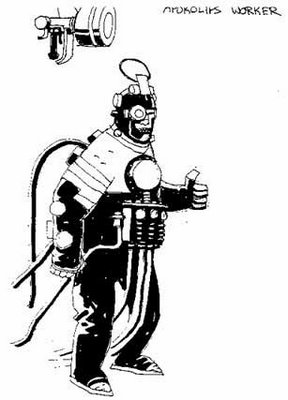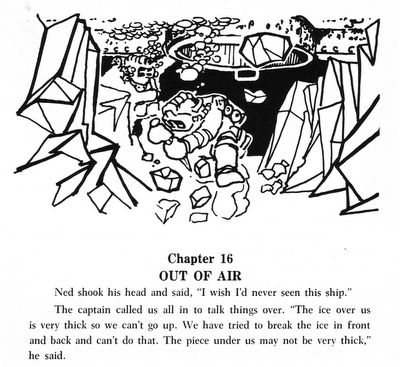Friday, January 19, 2007
The Flight of Bats

“The assumption has always been that bats evolved from some sort of flying squirrel-type animals,” says Swartz. “Gliding has evolved in mammals seven times. That tells us that it’s really easy for an animal with skin to evolve into a glider, but going from a square gliding wing to a long, skinny flapping wing has not happened seven times. It might have happened once. And now it doesn’t look like bats have any relationship to these gliding things.”
Bat wings are highly articulated, with more than two dozen independent joints and a thin flexible membrane covering them. Birds and insects can fold and rotate their wings during flight, but bats have many more options. Their flexible skin can catch the air and generate lift or reduce drag in many different ways. During straightforward flight, the wing is mostly extended for the down stroke, but the wing surface curves much more than a bird’s does – giving bats greater lift for less energy. During the up stroke, the bats fold the wings much closer to their bodies than other flying animals, potentially reducing the drag they experience. The wing’s extraordinary flexibility also allows the animals to make 180-degree turns in a distance of less than half a wingspan. link
Direct measurements of the kinematics and dynamics of bat flight. 2007. Xiaodong Tian et al 2006 Bioinspir. Biomim. 1 S10-S18
Tuesday, January 16, 2007
Vaughn Bode's 20,000 Leagues Under the Sea: Part 7
Back in the 60’s Vaughn Bodé illustrated a number of classics that had been rewritten for “reading challenged” kids. The books were published by Frank E. Richards and sold exclusively to schools.
Because these books are almost impossible to find at reasonable prices I’ll be posting all the illos from the best book of the bunch, “Jules Verne’s ’20,000 Leagues Under The Sea” in eight installments.
Read: Part 1 Part 2 Part 3 Part 4 Part 5 Part 6 Part 7 Part 8
Because these books are almost impossible to find at reasonable prices I’ll be posting all the illos from the best book of the bunch, “Jules Verne’s ’20,000 Leagues Under The Sea” in eight installments.
Read: Part 1 Part 2 Part 3 Part 4 Part 5 Part 6 Part 7 Part 8
All art © the estate of Vaughn Bodé
Sunday, January 14, 2007
Idaho To Drive Wolves To Point Of Extinction
Idaho's governor said Thursday he will support public hunts to kill all but 100 of the state's gray wolves after the federal government strips them of protection under the Endangered Species Act.
Gov. C.L. “Butch'' Otter told The Associated Press that he wants hunters to kill about 550 gray wolves. That would leave about 100 wolves, or 10 packs, according to a population estimate by state wildlife officials. The 100 surviving wolves would be the minimum before the animals could again be considered endangered.
“I'm prepared to bid for that first ticket to shoot a wolf myself,'' Otter said earlier Thursday during a rally of about 300 hunters. The hunters, many wearing camouflage clothing and blaze-orange caps, applauded wildly during his comments.
Suzanne Stone, a spokeswoman for the advocacy group Defenders of Wildlife in Boise, said Otter's proposal would return wolves to the verge of eradication. “Essentially he has confirmed our worst fears for the state of Idaho: That this would be a political rather than a biological management of the wolf population,'' Stone said. “There's no economic or ecological reason for maintaining such low numbers. It's simple persecution.'' link from Live Science.com
Where’s Larry Talbot when you need him…?
Gov. C.L. “Butch'' Otter told The Associated Press that he wants hunters to kill about 550 gray wolves. That would leave about 100 wolves, or 10 packs, according to a population estimate by state wildlife officials. The 100 surviving wolves would be the minimum before the animals could again be considered endangered.
“I'm prepared to bid for that first ticket to shoot a wolf myself,'' Otter said earlier Thursday during a rally of about 300 hunters. The hunters, many wearing camouflage clothing and blaze-orange caps, applauded wildly during his comments.
Suzanne Stone, a spokeswoman for the advocacy group Defenders of Wildlife in Boise, said Otter's proposal would return wolves to the verge of eradication. “Essentially he has confirmed our worst fears for the state of Idaho: That this would be a political rather than a biological management of the wolf population,'' Stone said. “There's no economic or ecological reason for maintaining such low numbers. It's simple persecution.'' link from Live Science.com
Where’s Larry Talbot when you need him…?
Saturday, January 13, 2007
New SETI Search Looks For Warring Aliens
Do extraterrestrials sweep their skies with radar to scan for incoming missiles?If so, Avi Loeb of the Harvard-Smithsonian Center for Astrophysics in Cambridge, Massachusetts, thinks he can find the radio signals leaked from warring alien civilizations.
Loeb believes he can detect the leaked signals by piggybacking his search on a new generation of radio telescopes designed to study low-frequency radio emissions in the distant, infant universe.
He and his colleagues hope to test the theory with the Mileura Wild-Field Array currently under construction in Australia and is slated to start operations in 2008.
In its current configuration, the array will be sensitive to any Earth-like civilizations that may exist on a planet orbiting one of about a thousand stars up to 30 light-years away, Loeb said. link
And the war rages on...:
Friday, January 12, 2007
New Life Forms Found In Arctic Ocean
Artic Ocean researchers have discovered a new group of microscopic organisms, which they have baptized "picobiliphytes": pico because of their extremely small size, measured in millionths of a meter, bili because they contain biliproteins, highly fluorescent substances that transform light into biomass, and phyte meaning they are plants.
The discovery came from carefully analyzing DNA sequences belonging to vast communities of micro-organisms living in the ocean. "There was one group of sequences that just didn't line up with any of the known groups," explains Dr. Lovejoy. "In fact, the divergence of this group from known organisms is as great as the difference between land plants and animals," adds the scientist. link
Picobiliphytes: A Marine Picoplanktonic Algal Group with Unknown Affinities to Other Eukaryotes. 2006. F. Not et al. Science 315: 253-255.
Picobiliphytes Will Rock You!:
The discovery came from carefully analyzing DNA sequences belonging to vast communities of micro-organisms living in the ocean. "There was one group of sequences that just didn't line up with any of the known groups," explains Dr. Lovejoy. "In fact, the divergence of this group from known organisms is as great as the difference between land plants and animals," adds the scientist. link
Picobiliphytes: A Marine Picoplanktonic Algal Group with Unknown Affinities to Other Eukaryotes. 2006. F. Not et al. Science 315: 253-255.
Picobiliphytes Will Rock You!:
Subscribe to:
Posts (Atom)


















